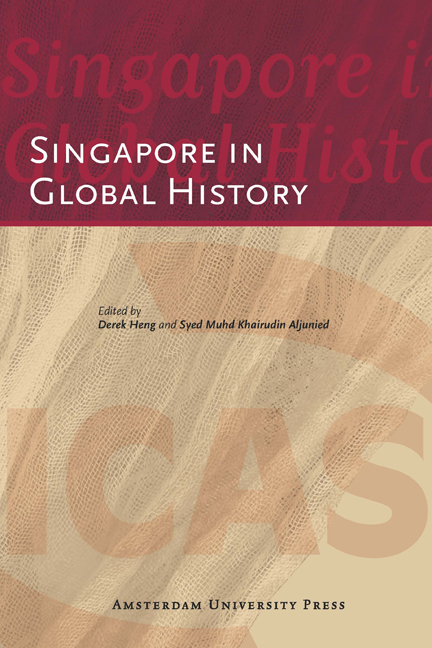Book contents
- Frontmatter
- Contents
- List of Tables and Illustrations
- Foreword
- 1 Globalising the History of Singapore
- 2 Situating Temasik within the Larger Regional Context: Maritime Asia and Malay State Formation in the Pre-Modern Era
- 3 The Singapore River/Port in a Global Context
- 4 ‘Walls of Illusion’: Information Generation in Colonial Singapore and the Reporting of the Mahdi-Rebellion in Sudan, 1887-1890
- 5 The Littoral and the Literary: Making Moral Communities in the Straits Settlements and the Gold Coast in the late Nineteenth and Early Twentieth Century
- 6 Social Discourse and Economic Functions: The Singapore Chinese in Japan’s Southward Expansion between 1914 and 1941
- 7 The Dynamics of Trans-Regional Business and National Politics: The Impact of Events in China on Fujian-Singapore Tea Trading Networks, 1920-1960
- 8 Rambutans in the Picture: Han Wai Toon and the Articulation of Space by the Overseas Chinese in Singapore
- 9 The Global Effects of an Ethnic Riot: Singapore, 1950-1954
- 10 The British Military Withdrawal from Singapore and the Anatomy of a Catalyst
- 11 Bringing the International and Transnational back in: Singapore, Decolonisation, and the Cold War
- 12 The Global and the Regional in Lee Kuan Yew’s Strategic Thought: The Early Cold War Years
- 13 A Brief History of the Hub: Navigating between ‘Global’ and ‘Asian’ in Singapore’s Knowledge Economy Discourse
- About the Contributors
- Bibliography
- Miscellaneous Endmatter
6 - Social Discourse and Economic Functions: The Singapore Chinese in Japan’s Southward Expansion between 1914 and 1941
Published online by Cambridge University Press: 02 February 2021
- Frontmatter
- Contents
- List of Tables and Illustrations
- Foreword
- 1 Globalising the History of Singapore
- 2 Situating Temasik within the Larger Regional Context: Maritime Asia and Malay State Formation in the Pre-Modern Era
- 3 The Singapore River/Port in a Global Context
- 4 ‘Walls of Illusion’: Information Generation in Colonial Singapore and the Reporting of the Mahdi-Rebellion in Sudan, 1887-1890
- 5 The Littoral and the Literary: Making Moral Communities in the Straits Settlements and the Gold Coast in the late Nineteenth and Early Twentieth Century
- 6 Social Discourse and Economic Functions: The Singapore Chinese in Japan’s Southward Expansion between 1914 and 1941
- 7 The Dynamics of Trans-Regional Business and National Politics: The Impact of Events in China on Fujian-Singapore Tea Trading Networks, 1920-1960
- 8 Rambutans in the Picture: Han Wai Toon and the Articulation of Space by the Overseas Chinese in Singapore
- 9 The Global Effects of an Ethnic Riot: Singapore, 1950-1954
- 10 The British Military Withdrawal from Singapore and the Anatomy of a Catalyst
- 11 Bringing the International and Transnational back in: Singapore, Decolonisation, and the Cold War
- 12 The Global and the Regional in Lee Kuan Yew’s Strategic Thought: The Early Cold War Years
- 13 A Brief History of the Hub: Navigating between ‘Global’ and ‘Asian’ in Singapore’s Knowledge Economy Discourse
- About the Contributors
- Bibliography
- Miscellaneous Endmatter
Summary
This chapter examines the strategies and effects of the Japanese-Chinese alliances in Singapore as well as their impacts on changing Japanese views of overseas Chinese in the South Seas (present-day Southeast Asia). The literature on Chinese in Singapore in the first half of the twentieth century has emphasised how the British colonial city port developed as the centre of Chinese anti-Japanese nationalism in the region from the 1920s to the 1930s (Akashi 1970; Leong 1977, 1979; Wang 1981; Yong 1987; Heng 1988; Yen 1989; Ku 1994; Horimoto 1997). Based on research into Japanese intelligence reports on the South Seas, this chapter, nonetheless, emphasises Singapore's role in shaping Japanese strategies in dealing with the Chinese in the South Seas in the early twentieth century.
The importance of Singapore in the formulation of Japan's strategies during its southward advance rested not only on trade but also on the Chinese responses to the Japanese expansion. The responses varied among the different Chinese sub-ethnic groups. The latter, who were organised along origin and dialect lines, developed into different immigrant and business networks such as the Hokkien, Teochew, Cantonese, Hakka, and Hainanese. In the late Meiji (1868-1911) and Taishō ( 1912-1926) eras, Japan's main aim was to cultivate ‘Japan-China friendship’ (Nisshi Shinzen [日支親善]) in dealing with the Chinese in the South Seas. It successfully incorporated the transnational Chinese networks, above all the most influential Hokkien networks in Java and Singapore, into the Japanese state-sponsored programmes centred in Taiwan, then a Japanese colony. This agenda, however, failed after the late 1920s, when the Chinese bourgeoisie, especially those from the Hokkien and Teochew circles, began to organise Chinese anti-Japanese nationalist movements. After that, Japan began to work more closely with the non-Chinese merchants, including the Malays and Indian merchants, while framing the Chinese as outsiders and exploiters of the natives in the region. Although some Chinese (especially those from the Cantonese sub-ethnic group) continued to import goods from Japan to Singapore despite the surge of Chinese anti-Japanese nationalism throughout the 1930s, Japan viewed these Cantonese merchants as competitors rather than collaborators.
- Type
- Chapter
- Information
- Singapore in Global History , pp. 111 - 134Publisher: Amsterdam University PressPrint publication year: 2012



